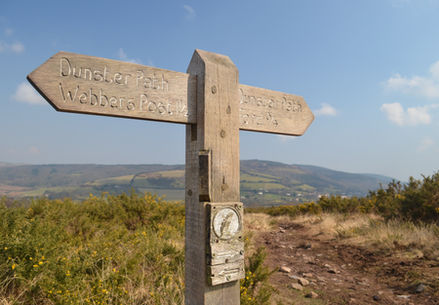Green Travel Guide to Exmoor National Park
In turns serene and severe, forbidding and bucolic, harsh and homely, Exmoor has long captured the imagination of poets and novelists: Shelley and Coleridge were drawn here, and R. D. Blackmore immortalised the area in his novel Lorna Doone – a literary pilgrimage to the Doone Valley is as good a reason as any to delve into the moor’s interior. The coast, though, has its own drama: Britain’s longest national trail follows the moor’s extremity as it soars to the top of England’s highest sea cliffs and plunges to rocky coves. Superb walking trails cover the region, including the South West Coast Path and the Two Moors Way.
Foreword by Exmoor National Park Authority
Exmoor is a truly diverse National Park. A dramatic coastline, with some of the highest cliffs in the country, is backed by wild moorlands, incised with steep wooded valleys and combes. Small villages are scattered across the landscape offering a warm welcome to all. Whether you’re after an outdoor adventure, want to walk in the footsteps of the romantic poets or simply wish to relax amongst 8,000 years of history, Exmoor has something for all.
Wildlife abounds. The famous Exmoor ponies (one of the oldest breeds in the world) roam freely across the open moorland which also hosts the largest herds of red deer in England. Salmon and trout swim happily in our streams whilst dippers, owls, bats, birds of prey and rare butterflies can be seen in the skies above. The skies of Exmoor are famous too, being some of the darkest around affording superb opportunities for stargazing. In 2011 the National Park became the very first area in Europe to be designated an International Dark Sky Reserve and only the second in the world!
Whether by day or night there is plenty to do and every year millions of visitors enjoy this special place. This Green Traveller's Guide to Exmoor National Park provides plenty of ideas and specifically highlights those activities and businesses that are working hard to look after the National Park, minimising their impact on the environment and enhancing your experience.
Exmoor was one of the first National Parks in the country to gain the ‘European Charter for Sustainable Tourism in Protected Areas’ and we’re continually striving to ensure everyone can enjoy the National Park whilst helping to look after it. We hope to see you here soon!
Photos: Visit Exmoor

What Green Traveller's writers discovered in Exmoor National Park
Stay, Eat, See & Do
Our pick of places across the glorious Exmoor National Park
Written by Paul Blooomfield
Google Map Key:
Click on the coloured icons for more information about each listing
Green = Places to stay; Blue = Places to eat; Yellow = Attractions; Purple = Activities
Click on the square brackets top right of map to reveal expanded map

-
Exmoor National Park is Europe’s first International Dark Sky Reserve
-
The country’s longest path, the South West Coast Path, starts its 630-mile route traversing the
36-mile coastline of the National Park
-
The National Park is home to the tallest tree in England, which can be found in the Crown Estates Dunster Forest
-
The rugged coastline is home to the highest sea cliffs on the British mainland
-
Exmoor ponies are the UK's oldest breed of horse
-
Exmoor is home to the largest herds of free-living red deer (Britain’s largest native mammal) in the country
Words by Paul Bloomfield.
Artwork for Green Traveller's Guides by Tina Smith and Mark Edwards.





